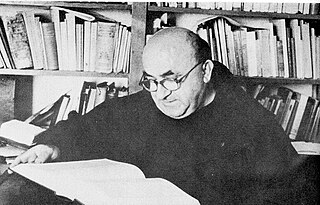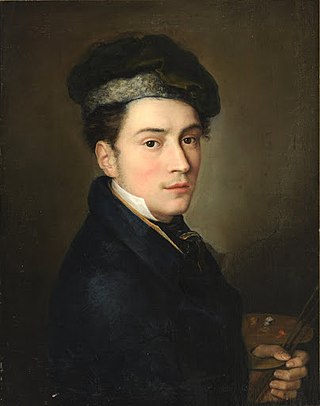The Roman Curia comprises the administrative institutions of the Holy See and the central body through which the affairs of the Roman Catholic Church are conducted. The Roman Curia is the institution which the Roman Pontiff ordinarily makes use of in the exercise of his supreme pastoral office and universal mission in the world. It is at the service of the Pope, successor of Peter, and of the Bishops, successors of the Apostles, according to the modalities that are proper to the nature of each one, fulfilling their function with an evangelical spirit, working for the good and at the service of communion, unity and edification of the Universal Church and attending to the demands of the world in which the Church is called to fulfill its mission.

Benedetto Luti was an Italian painter, draftsman, and pastelist.
In the Roman Curia of the Catholic Church, a congregation is a type of department of the Curia. They are second-highest-ranking departments, ranking below the two Secretariats, and above the pontifical councils, pontifical commissions, tribunals and offices.
A pontifical academy is an academic honorary society established by or under the direction of the Holy See. Some were in existence well before they were accepted as "Pontifical."

The Pontifical Academy of Sciences is a scientific academy of the Vatican City, established in 1936 by Pope Pius XI. Its aim is to promote the progress of the mathematical, physical, and natural sciences and the study of related epistemological problems. The Accademia Pontificia dei Nuovi Lincei was founded in 1847 as a more closely supervised successor to the Accademia dei Lincei established in Rome in 1603 by the learned Roman Prince, Federico Cesi (1585–1630), who was a young botanist and naturalist, and which claimed Galileo Galilei as its president. The Accademia dei Lincei survives as a wholly separate institution.

Antonio Cavallucci was an eighteenth-century Italian painter of religious scenes and portraits.
The Prefecture of the Papal Household is the office in charge of the Papal Household, a section of the Roman Curia that comprises the Papal Chapel and the Papal Family.

The Pontifical Academy of Social Sciences is a pontifical academy established on 1 January 1994 by Pope John Paul II and is headquartered in the Casina Pio IV in Vatican City. It operates much like other learned societies worldwide, but has the special task of entering into dialogue with the Church. Its scientific activities are organised and focused to promote this dialogue.

The Casina Pio IV is a patrician villa in Vatican City which is now home to the Pontifical Academy of Sciences, the Pontifical Academy of Social Sciences and the Pontifical Academy of St. Thomas Aquinas. The predecessor of the present complex structure was begun in the spring of 1558 by Pope Paul IV in the Vatican Gardens, west of the Cortile del Belvedere. Paul IV commissioned the initial project of the 'Casina del Boschetto', as it was originally called, from an unknown architect; the first mention of the single-storey building can be found on 30 April 1558, and a notice of the following 6 May, says that the Pope spent "two thirds of his time at the Belvedere, where he has begun to build a fountain in the woods".
The Pontifical Biblical Commission is a pontifical commission established within the Roman Curia to ensure the proper interpretation and defense of the Bible.

The Pontifical Academy of Saint Thomas Aquinas is a pontifical academy established on 15 October 1879 by Pope Leo XIII. The academy is one of the pontifical academies housed along with the academies of science at Casina Pio IV in Vatican City, Rome.
The Pontifical Academy of Martyrs is one of the ten Pontifical Academies established by the Holy See. It serves to advance the cult of saints and martyrs and the study of related early Christian history, including the catacombs. It operates with guidance and support from the Congregation for Divine Worship and the Discipline of the Sacraments and the Roman Curia.
The Pontifical Academy of Archaeology is an academic honorary society established in Rome by the Catholic Church for the advancement of Christian archaeological study. It is one of the ten such Pontifical Academies established by the Holy See.

The Pontifical Academy of Mary is an international pontifical organization tasked with promoting mariology. The academy is one of the Pontifical academies at the Vatican in Rome. The PAMI also has the task of coordinating the other Marian academies and societies that exist worldwide and of exercising vigilance against any Marian excess or minimalism. For this purpose the Pope directed that the Academy have a council that examines the organization of congresses, and that coordinates Mariological societies and those who promote or teach mariology.
The Pontifical Academy of Theology is a learned society founded in 1718, and is a Pontifical Academy. It is situated at Via della Conciliazione, Vatican City, Rome.
The Pontifical Academy for Latin is an organization established in 2012 to promote appreciation for the Latin language and culture. The Academy replaced the Latinitas Foundation, which Pope Paul VI erected in 1976, and is linked to the Dicastery for Culture and Education on which it depends. Its headquarters is located in Vatican City.
Accademia often refers to:

Pietro Gagliardi was an Italian painter and architect, who decorated many churches and palaces in Rome and throughout Italy.
Praedicate evangelium is an apostolic constitution reforming the Roman Curia and was published and promulgated on 19 March 2022 by Pope Francis; the document took effect on 5 June 2022.
The Dicastery for Culture and Education is an administrative unit of the Roman Curia. It began operations on 5 June 2022 as established by the apostolic constitution Praedicate evangelium promulgated on 19 March 2022. It was formed through the merger of two earlier bodies, the Pontifical Council for Culture and the Congregation for Catholic Education.








